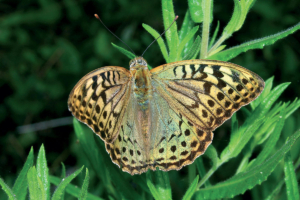BUTTERFLY GARDEN
Argynnis pandora
Denis & Schiffermüller, 1775 – (Pandora or Cardinal)
The cardinal butterfly is undoubtedly one of the most exciting encounters with the butterflies of the Tuscan Archipelago. A butterfly of large dimensions and with a particularly slow and elegant flight, distributed mainly in the central-southern regions, while in the Tuscan archipelago it can only be observed on the island of Elba and on Giglio, where it completes only one generation per year. It loves frequent visits to clearings and forest edges, where it flies from late May to the whole of September, feeding on the large inflorescences of daisy family such as the thistle. This butterfly species is easy to distinguish between the sexes, since the female is usually larger and has a distinct green coloring of the upper edge of both wings, while in the male this coloring is less distinct, but the middle part of the ribs of the enlarged forewings falls on fusiform, due to the presence of the so-called “androconial scales”. With closed wings at rest, one can see the rich “cardinal red” coloration at the lower edge of the forewings, from which one of the common names of this species derives. The larva feeds mainly on violets.
Charaxes jasius
Linnaeus, 1767 – (Strawberry tree nymph)
Undoubtedly the largest and most spectacular butterfly of all Italian fauna. Despite its size, it has a fairly fast flight, which it performs mainly near its nurse plant (strawberry tree), from which it takes its name, the Strawberry Tree Moth. The morphological feature that undoubtedly makes this species distinctive is the presence of 4 tails on the back part of the wings, a unique case in Italian butterflies. The two sexes are practically indistinguishable. He loves to visit the Mediterranean maquis with strawberry trees and heather, is attracted by the sugary substances of rotting fruit and does not shy away from approaching people when their good sweet wine is offered, which he greedily sucks and then mates with one goodbye to the slow and “breathtaking” flight! It occurs on all the islands of the Tuscan archipelago except Montecristo. The caterpillar feeds almost exclusively on strawberry tree leaves, where it usually weaves a kind of “silk bed” that it uses to rest when it does not want to eat.
Lasiommata megera
Linnaeus, 1767 – (Megera)
The wall fox is a medium-sized species that is certainly one of the most widespread and common throughout Italy and Europe. In the Tuscan archipelago it is absent only in Giannutri and Capraia. The morphological features that allow this species to be distinguished almost immediately are the uniform reddish-brown coloration and the presence of two conspicuous black eyespots with a white spot in the center, located at the corner of the upper surface of the forewings. It is a butterfly with a fast and swaying flight that prefers shady environments, with a particular fondness for forest trails. He has the habit of making frequent stops to warm up in areas lit by the sun’s rays. The wall fox appears from the first days of March to the end of October and completes up to 3 generations.





